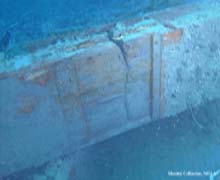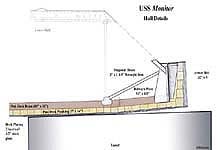
Divers cut through thick layers of the iron and wood hull and armor belt to gain access to the turret. Here, a cut can be seen in the armor belt. Click image for larger view and detailed explanation.

A detail of the Monitor's hull and armor belt resting atop the turret. Click image for larger view and detailed explanation.
Exposing the Turret
July 5, 2002
John Broadwater
Sanctuary Manager
Monitor National Marine Sanctuary
Today, the diving team completely uncovered the Monitor's famous gun turret for the first time in 140 years. At 7:57 pm, U.S. Navy divers and NOAA scientists removed a 30-ton section of the ship's hull and armor belt that has covered the turret since the warship sank on New Year's Eve, 1862.
Removing the hull section completed the first phase of Monitor Expedition 2002. This will allow for the recovery of the world's first armored, revolving gun turret—an innovation that can still be seen on today's warships. The Monitor's turret, with its two large Dahlgren cannons inside, is estimated to weigh nearly 150 tons. To gain access to the turret for excavation and recovery, a large portion of the ship's stern hull structure was removed. Before it could be removed and lifted, Navy divers had to remove tons of debris and coal, and cut through thick layers of iron and wood hull structure. Even after the turret is recovered, the site will remain an important archaeological site as remaining artifacts are found.
With the turret exposed, divers now will begin to install the 57,000-pound lifting frame, known as the "claw," and begin excavating the interior of the silt-filled turret. Following excavation, we will carefully raise the turret, which will be placed on the support barge, and transported to The Mariners' Museum in Newport News, Virginia. There, it will undergo conservation and be placed on exhibit.
NOAA and the Navy team celebrated the completion of this important milestone, and then got back to work with the excavation of the turret’s interior. Weather looks good for the next few days at the sanctuary, which will allow divers to continue to work around the clock.
Sign up for the Ocean Explorer E-mail Update List.

































